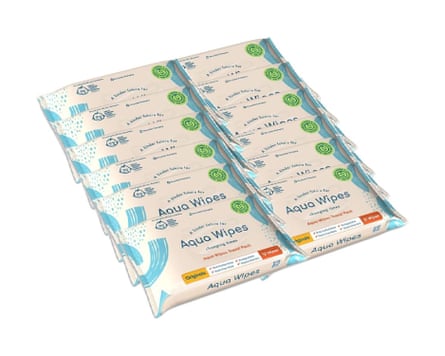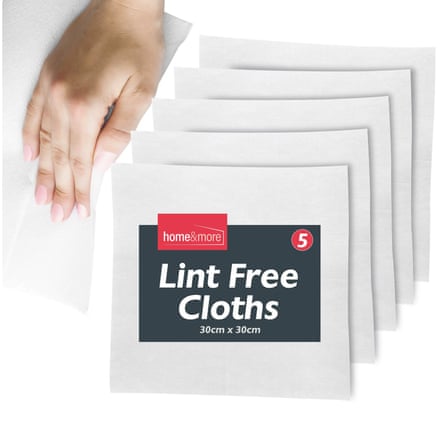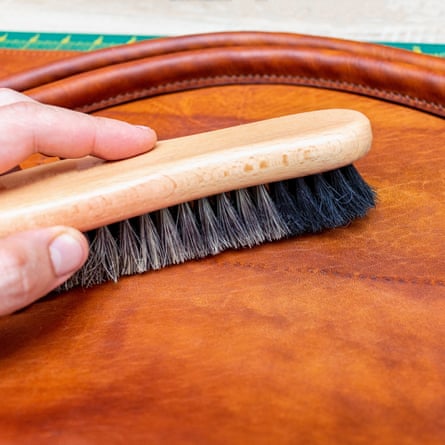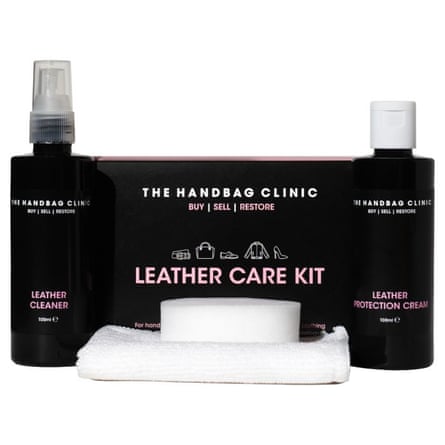Strong, beautiful and, if well looked after, endlessly long-lasting: leather has long been a staple of many of our wardrobes. And while there are ethical and environmental reasons to consider not buying new leather, the leather items you already own (or buy secondhand) could well outlast you, so it’s important to look after them properly. So, how do you make sure your favourite items – from a handbag to a beloved jacket – last so that you can pass them down the generations?
I spoke to experts to gather their tips and tricks for how best to clean, preserve and repair leather items, so that they keep being useful, and beautiful, for as long as possible.
How to make your leather clothing, shoes and accessories last longer
Know your leather
There are four main grades of leather. The highest are full grain and top grain, used for products such as designer handbags. Split leather is more affordable and made from a lower layer of the hide; depending on the way it has been finished, it can be smooth or soft to the touch. Split leather is generally less durable than the higher grades, but it’s used for everything from shoes to clothing to upholstery. Bonded leather is essentially a composite material that contains leather fibres, and is cheaper and less durable still.
The higher the grade, the longer the leather should last, says Antony Frith, owner of Shoe Healer, traditional cobblers in Doncaster. But you don’t need different products or methods to look after the different kinds: “As a rule, we treat them all the same,” he says.
That may be true for most smooth leathers, but textured materials such as suede and nubuck, unusual leathers such as buffalo hide and those with special finishes need a different approach. If you’re not sure what kind you’re dealing with, take it to a local cobbler for advice.
Clean carefully

To remove everyday grime from smooth leather, use baby wipes, says Roque Furtado at JT Batchelor, a specialist leather supplier in London. Gently brush off any dry dust or dirt, then wipe over the leather, without scrubbing or rubbing too hard.
If the grime is ingrained and that doesn’t do the job, the next step is saddle soap, which comes as a bar, paste or spray. “The spray is generally easiest to use,” Furtado says. JT Batchelor sells US brand Fiebing’s, but there are plenty of others available (try Decathlon). Again, brush off dry dirt, then, using a damp cloth, work up a lather with the soap and rub gently over the leather. Rinse the cloth and wipe away any remaining foam.
For textured materials such as suede and nubuck, some (including Nike) recommend white vinegar. Put a little vinegar (you can dilute and use half water and half vinegar, if you prefer) on to a lint-free cloth and clean the area gently. Or brush with a suede brush and use a dedicated suede cleaning product. For patent finishes, just use a soft, damp cloth.
“You don’t need to buy the products made by the brand selling you the bag or shoes,” says Dai Rees, designer and programme director for craft at the London College of Fashion. “It will be the same compounds and materials as any other.” Hermès, for example, sells its own glycerine soap bar for leather for £40, while Lincoln Horse Care sells a similar bar for £6.99.
Whatever product you use, always test it on a small inconspicuous area first, to check it doesn’t alter the finish or affect the colour, and let it dry completely before using it on the rest of the item.
How often you should clean your shoes depends on how frequently you wear them, and whether you’re traipsing across muddy fields or hopping in and out of Ubers in them. But keeping the leather clean, nourished and in good condition should help them last longer.

Aqua Wipes biodegradable plastic-free baby wipes
£1.90 for a pack of 56 at Boots
£5 for 12 packs of 12 at Amazon

Tesco distilled vinegar

Lint-free cleaning cloths

Solid glycerine soap for shoes and leather

The Scratch Doctor suede and nubuck cleaner and brush
Remove stains

What if you get a red wine stain on a cream bag or tomato sauce on a suede jacket? Your chances of getting it out depend somewhat on the kind of leather you have. Leather is generally processed in one of two ways: vegetable tanning or chrome tanning.
Chrome creates a resistant surface, while vegetable methods, favoured by high-end and sustainable brands, leave the grain of the leather more open. “Leather that has been vegetable tanned tends to have a more natural look, with a more open grain. It weathers beautifully, but it is more susceptible to moisture or marks. Chrome tanned leather tends to be smoother to the touch,” says Frith.
When red wine splashes on to a chrome-tanned bag, “it may repel the liquid”, he says. But with vegetable tanned or older leather where the grain has opened up, it’s likely to stain.
That said, you might still be able to save it. First, use saddle soap, then let it dry completely. “Then you have to recolour it, and the best way to do that is with a spray dye that resurfaces the leather,” Frith says. He recommends Saphir’s Tenax leather dye or Magix for smooth leather, while Saphir’s Renovétine protects and revives suede and nubuck.
There are no guarantees, of course, and as ever, you should test on a small section that can’t be seen first. If in doubt, ask a local cobbler or professional cleaner for advice on the best approach.

Saphir Tenax leather dye spray

Magix leather dye spray

Saphir Renovétine suede reviver spray
£16.95 for 200ml at eBay
£10.72 for 200ml at Amazon
Nourish – and protect from the elements

“Treat leather as the skin it is,” says Sarah Spicer, shoemaker at Green Shoes in Devon. “It needs to be conditioned and moisturised.”
For smooth leather, Frith says, “the number one rule is that hard polish is no good. You’ve got to use a cream. If you leave a tin of shoe polish out, it will soon dry up and crack. And it will do the same thing to your shoes or bag. Cream nourishes.”
after newsletter promotion
Frith recommends Saphir, but there are plenty of other creams on the market. To use it, remove any dirt and make sure the shoes are dry, then apply using a soft cloth in circular motions.
Rees, meanwhile, suggests using a soft cloth to apply beeswax (like this one), and Furtado recommends Chelsea Dubbin Leather Food, which has been made since the late 19th century. Apply with a soft cloth and leave overnight to sink in.
Some experts recommend applying products like these whenever you clean your shoes, or once every four to six weeks. But don’t overdo it, says Spicer. “You can tell when things have been overconditioned because they feel greasy. You can be sparing.”
For nubuck and suede, Furtado says a spray-on waterproofer is all you should use. Tesco and John Lewis stock Cherry Blossom shoe protector to stave off rain damage. Frith says nano sprays are “superb”. These (such as Crep Protect) form a protective layer against moisture and oils – and might protect against stains, too. Follow the instructions on the packaging to find out how often you should spray them, as this varies. “We sell some that recommend you spray every three to four weeks, and others that say every six months,” Frith says.
If you get caught in the rain, don’t dry leather by the radiator and don’t use a hairdryer. Let it dry naturally, then treat it again with the right protective product.

Saphir Crème Surfine shoe cream
£9.75 for 50ml at eBay
£9.20 for 50ml at Amazon

Beeswax leather balsam

Cherry Blossom Eco Ultra Repel

Crep Protect

The Handbag Clinic leather care kit
Store safely
Always store leather items in a clean, dry place out of direct sunlight, says Edyta Knapinska, handbag buyer at John Lewis, as it will prolong their life. Stow handbags in your wardrobe or a cupboard, inside a protective dust bag if you can. Sometimes these are thrown in when you buy a bag. If not, you can buy them (such as these ones made by Hayden Hill) to keep bags clean and dust-free. Dunelm and Ikea have a range of shoe cabinets.
Sunlight is particularly damaging when leather is vegetable tanned, as it will literally tan. “If you keep one shoe in the sun and the other in the shade, the one in the sun will end up darker.”
A boot-shaper will help avoid creases and strain on the zip from being folded, while some people swear by shoe trees for looking after favourite shoes, particularly those only worn occasionally. Frith says cedar is the best wood for these – it absorbs moisture and keeps them fresh.
When storing leather jackets, Frith says: “Leather is heavy and if you hang it from one point, it will sag and lose its shape. So use a sturdy hanger, not a coat hook.” Look for broad, rounded ends to keep the shoulders in shape, like on this one from John Lewis.
For long-term storage of leather jackets, Frith recommends first airing well (that can be outside, or anywhere air circulates, just not in a wardrobe), then hanging the jacket in a zip-up polythene garment bag. “Leather takes in moisture from the air and even from our bodies when we use it every day. But when you put these things away for a long time, the leather can dry out,” he says. “A polythene zip-up bag, like those you get from the dry cleaners, or even just a big polythene bag, will control the airflow. It won’t be completely airtight, but it will keep some moisture in and protect the leather from drying out.”

Eloise sliding shoe storage cabinet

Dasco boot shaper

Suit hanger

Moth-proof garment bag
Choose vintage leather carefully

Secondhand leather often has a wonderful patina and lived-in quality. But vintage leather can need a bit of love to bring it back to life. Charity shops and online stores such as Vinted and Vestiaire Collective are great hunting grounds for preloved leather jackets, bags and shoes, but check that a piece is not beyond repair before you buy, says Frith. “It’s much harder to restore and renovate old, worn or damaged leather than it is to take care of leather that is still in good shape,” he says.
“Where possible, check for signs of dryness or cracking. The leather on a briefcase or secondhand handbag might have survived well, but the cotton stitching could be deteriorating. So, when you’re buying anything at all, it’s good to stress test the leather and the stitching. Because you might find one day it just falls apart.” Pull and manipulate seams and any areas that look a bit tired, to make sure there are no signs of disintegration.
For online purchases, where you can’t hold the item in your hands, ask sellers to provide closeup photos of the areas that are most prone to cracking or strain – seams, straps or handles, zips and creases. If you decide to buy, look after the item well and you’ll be able to enjoy it for a long time to come.
Sandra Haurant is a journalist who has been writing for the Guardian for more than two decades. One of her favourite things is speaking to experts with a real passion for what they do, and pouring their knowledge into articles. Another of her favourite things is her dog, who has long hoped she will pitch a piece on pet spas

 3 months ago
98
3 months ago
98

















































